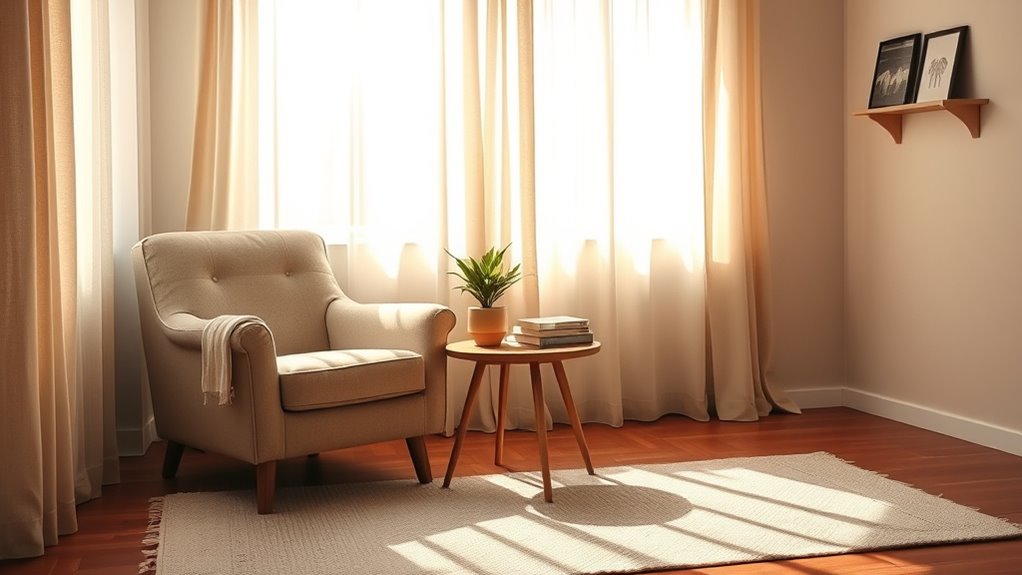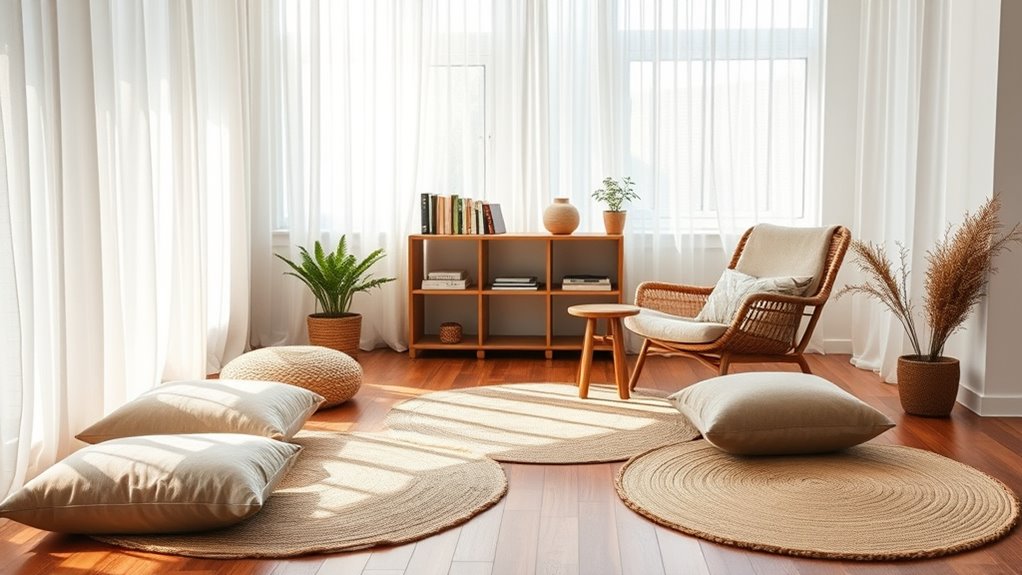Creating a screen-free sanctuary at home starts with choosing a quiet, comfortable spot and removing devices that tempt checking. Fill it with calming elements like soft lighting, cozy furniture, and natural textures. Establish clear boundaries, such as set times to unplug, and include offline activities like books or journaling. Making this space inviting and routines consistent helps you recharge mentally and emotionally. Keep exploring to discover more tips on how to make your detox room truly effective.
Key Takeaways
- Choose quiet, comfortable spaces and remove digital devices to create a dedicated screen-free sanctuary.
- Incorporate calming elements like soft lighting, natural textures, and cozy furniture to make the space inviting.
- Establish clear boundaries and rules for designated unplugging times, communicating them to household members.
- Fill the room with offline activities such as books, journals, art supplies, or meditation cushions.
- Develop consistent routines, like morning or evening sessions, to reinforce the habit of digital disconnection.

In a world dominated by constant digital connectivity, more people are seeking spaces to disconnect and recharge. Creating a digital detox room at home offers a dedicated space where you can truly unplug and escape the constant barrage of notifications, emails, and social media. This is where tech free zones come into play, transforming a corner of your house into a sanctuary free from screens and digital distractions. The idea is to design a space that encourages relaxation, mindfulness, and genuine human connection, away from the digital world’s demands. Setting up a digital detox room starts with establishing unplugging strategies that make it easier for you to switch off and stay offline.
Create a digital detox room to unwind, disconnect, and foster mindfulness away from screens and digital distractions.
Begin by choosing a quiet, comfortable space—perhaps a spare bedroom, a corner in your living room, or even a basement. The goal is to remove any devices that tempt you to check your phone or laptop. Replace screens with calming elements—soft lighting, cozy furniture, and natural textures like wood or linen. Incorporate activities that promote mindfulness such as books, journals, art supplies, or meditation cushions. These items serve as alternatives to digital entertainment and encourage you to engage in more meaningful, offline pursuits.
To make your tech free zone inviting, set clear boundaries and rules. Decide on specific times when no devices are allowed, and communicate these boundaries to family members or housemates. Using unplugging strategies like placing your phone in a drawer or turning it off during designated times helps reinforce your commitment. You can also use physical cues like a sign or a specific decorative element to remind yourself that this space is dedicated solely to disconnecting. Additionally, understanding that creativity can be cultivated through offline activities may motivate you to make the most of your detox space, encouraging innovative thinking and problem-solving without digital interference.
Another effective approach is to create routines that support your digital detox goals. For example, dedicate the first 30 minutes of your day or the last hour before bed to activities in your detox room—reading, journaling, stretching, or simply sitting quietly. These routines help reinforce the habit of unplugging and make it easier to resist the urge to reach for your devices. Over time, your detox room becomes a natural retreat, a place where you can reset your mental state and reconnect with yourself without digital interruptions.
Frequently Asked Questions
How Often Should I Use a Digital Detox Room?
You should use a detox room based on your screen time guidelines and personal needs. Typically, aim for a weekly or bi-weekly detox, but listen to your body — if you feel overwhelmed or distracted, increase your screen-free time. Maintain your detox room regularly by keeping it clutter-free and inviting. This consistency helps you reset mentally and reduces digital fatigue, making your screen-free sanctuary more effective and enjoyable.
Can Digital Detox Rooms Improve Mental Health?
Digital detox rooms can definitely improve your mental health by fostering mindfulness practices and creating calming sensory environments. When you spend time in these spaces, you give your mind a break from constant screen exposure, reducing stress and anxiety. By intentionally disconnecting, you promote mental clarity and emotional resilience. Incorporating sensory elements like soft lighting and calming sounds helps deepen relaxation, making your mental health stronger and more balanced over time.
What Are Some Budget-Friendly Detox Room Ideas?
You can create a budget-friendly detox room by using DIY decor to personalize the space without spending much. Incorporate inexpensive, comfortable budget furnishings like cushions, rugs, or bean bags to make it cozy. Use natural elements like plants or candles to enhance relaxation. Rearrange existing furniture or repurpose items to define your screen-free sanctuary. Small changes like these make your detox room inviting and affordable, promoting mental clarity and calming your mind.
How Do I Involve Family Members in Detox Routines?
You might be surprised how effective family involvement can be in establishing shared routines. To do this, encourage open conversations about detox benefits, set collective goals, and create fun, screen-free activities everyone can enjoy. When everyone participates, it becomes easier to stick to routines and foster a supportive environment. Remember, involving your family makes the detox more enjoyable and sustainable, turning it into a bonding experience rather than a chore.
Are There Specific Activities Recommended for Detox Rooms?
You can include mindful activities and creative pursuits in your detox room to make it more effective. Try activities like meditation, deep breathing, or journaling to promote relaxation. Incorporate arts and crafts, drawing, or playing musical instruments to engage your mind creatively. These activities help you disconnect from screens and foster a peaceful environment, making your detox room a true sanctuary for mental clarity and rejuvenation.
Conclusion
Creating a digital detox room offers a gentle escape from constant connectivity, allowing you to reconnect with yourself and your surroundings. By designating a screen-free sanctuary at home, you give yourself a peaceful refuge, free from the digital noise that often overwhelms. Embrace this quiet corner as a chance to refresh your mind and nurture your well-being. Sometimes, a little less screen time can open the door to a richer, more balanced life.









